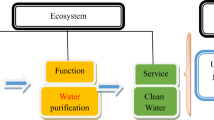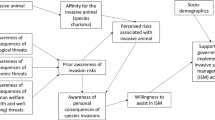Abstract
A three-way treatment design is used to compare contingent valuation response formats. Respondents are asked to value an endangered species (the red-cockaded woodpecker) and the restoration of its habitat following a natural disaster. For three question formats (open-ended, payment card, and double-bounded dichotomous choice), differences in survey response rates, item non-response rates, and protest bids are examined. Bootstrap techniques are used to compare means across formats and to explore differences in willingness to pay (WTP) distribution functions. Convergent validity is found in a comparison of mean WTP values, although some differences are apparent in the cumulative distribution functions. Differences across formats are also identified in item non-response rates and proportion of protest bids. Overall, the payment card format exhibits desirable properties relative to the other two formats.
Similar content being viewed by others
References
Babbie, E. (1995), The Practice of Social Research. Belmont, CA: Wadsworth Publishing Co., 7th edition.
Bowker, J. M. and J. R. Stoll (1988), ‘Use of Dichotomous Choice Nonmarket Methods to Value the Whooping Crane Resource’, American Journal of Agricultural Economics 70, 372-381.
Boyle, K. J. and R. C. Bishop (1988), ‘Welfare Measurements Using Contingent Valuation: A Comparison of Techniques’, American Journal of Agricultural Economics 70, 20-28.
Boyle, K. J., F. R. Johnson and D. W. McCollum (1997), ‘Anchoring and Adjustment in Single-bounded, Contingent Valuation Questions’, American Journal of Agricultural Economics 79, 1495-1500.
Boyle, K. J., F. R. Johnson, D. W. McCollum, W. H. Desvousges, R. W. Dunford and S. P. Hudson (1996), ‘Valuing Public Goods: Discrete versus Continuous Contingent-Valuation Responses’, Land Economics 72, 381-396
Boyle, K. J., H. F. MacDonald, H. Cheng, and D.W. McCollum (1998), ‘Bid Design and Yea-Saying in Single-Bounded, Dichotomous-Choice Questions’, Land Economics 74, 49-64.
Brown, T. C., P. A. Champ, R. C. Bishop and D. W. McCollum (1996), ‘Which Response Format Reveals the Truth about Donations to a Public Good?’ Land Economics 72, 152-166.
Cameron, T. A. and D. Huppert (1991), ‘Referendum Contingent Valuation Estimates: Sensitivity to the Assignment of Offered Values’, Journal of the American Statistical Association 86, 910-918.
Cameron, T.A. and J. Quiggin (1994), ‘Estimation Using Contingent Valuation Data from a ‘Dichotomous Choice with Follow-Up’ Questionnaire’, Journal of Environmental Economics and Management 27, 218-234.
Carmines, E. G. and R. A. Zeller (1979), Reliability and Validity Assessment. Beverly Hills, CA: Sage Publications.
Carson, R. T. (1991), ‘Constructed Markets’, in J. B. Braden and C. D. Kolstad (eds.), Measuring the Demand for Environmental Quality. New York: North-Holland.
Cummings, R. G., D. S. Brookshire and W. D. Schulze (eds.) (1986), Valuing Environmental Goods — An Assessment of the Contingent Valuation Method. Totowa: Rowman & Allanheld.
Dalecki, M. G., J. C. Whitehead and G. C. Blomquist (1993), ‘Sample Non-response Bias and Aggregate Benefits in Contingent Valuation: an Examination of Early, Late and Non-Respondents’, Journal of Environmental Management 38, 133-143.
Desvousges, W. H., F. R. Johnson, R. W. Dunford, K. J. Boyle, S. P. Hudson and K. N. Wilson (1993), ‘Measuring Natural Resource Damages with Contingent Valuation: Tests of Validity and Reliability’, in J. A. Hausman (ed.), Contingent Valuation: A Critical Assessment. New York: North-Holland.
Desvousges, W. H., V. K. Smith, D. Brown and D. K. Pate (1984), ‘The Role of Focus Groups in Designing a Contingent Valuation Survey to Measure the Benefits of Hazardous Waste Management Regulations.’ Draft report to the U.S. Environmental Protection Agency. Research Triangle Park, NC: Research Triangle Institute.
Dillman, D. A. (1978), Mail and Telephone Surveys: The Total Design Method. New York: John Wiley and Sons.
Duffield, J. and D. Patterson (1991), ‘Inference and Optimal Design for a Welfare Measure in Dichotomous Choice Contingent Valuation’, Land Economics 67, 225-239.
Federal Register (1993), ‘Natural Resource Damage Assessments Under the Oil Pollution Act of 1990’, Department of Commerce, National Oceanic and Atmospheric Administration, 15 CFR Chapter IX. 58(10), 4601-4614. Friday, January 15.
Fisher, A. C. (1994), ‘The Conceptual Underpinnings of the Contingent Valuation Method.’ Paper presented at the DOE/EPA Workshop on Using Contingent Valuation to Measure Non-Market Values. Herndon, Virginia, May 19–20.
Freedman, D. A. and S. C. Peters (1984), ‘Bootstrapping a Regression Equation: Some Empirical Results’, Journal of the American Statistical Association 79, 97-106.
Greene, W. (1992), LIMDEP Version 6.0: User's Manual and Reference Guide. Bellport, New York: Econometric Software, Inc.
Hanemann, W. M., J. Loomis and B. Kanninen (1991), ‘Statistical Efficiency of Double-Bounded Dichotomous Choice Contingent Valuation’, American Journal of Agricultural Economics 73, 1255-1263.
Herriges, J. A. and J. F. Shogren (1996), ‘Starting Point Bias in Dichotomous Choice Valuation with Follow-up Questioning’, Journal of Environmental Economics and Management 30, 112-131.
Holmes, T. P. and R. A. Kramer (1995), ‘An Independent Sample Test of Yea-Saying and Starting Point Bias in Dichotomous-Choice Contingent Valuation’, Journal of Environmental Economics and Management 29, 121-132.
Hooper, R. G., J. C. Watson and R. E. F. Escano (1990), ‘Hurricane Hugo's initial Effects on Red-cockaded Woodpeckers in the Francis Marion National Forest’, Transactions of the Fifty-Fifth North American Wildlife and Natural Resource Conference.
Huang, J. C. and V. K. Smith (1998), ‘Monte Carlo Benchmarks for Discrete Response Valuation Methods’, Land Economics 74, 186-202.
Johnson, R. L., N. S. Bregenzer and B. Shelby (1990), ‘Contingent Valuation Question Formats: Dichotomous Choice versus Open-Ended Responses’, in R. L. Johnson and G. V. Johnson (eds.), Economic Valuation of Natural Resources: Issues, Theory, and Applications. Boulder, CO: Westview Press, Chapter 12.
Kalton, G. and D.W. Anderson (1986), ‘Sampling Rare Populations’, Journal of the Royal Statistical Society (A) 149, 65-82.
Kanninen, B. J. (1995), ‘Bias in Discrete Response Contingent Valuation’, Journal of Environmental Economics and Management 28, 114-125.
Kealy, M. and R. W. Turner (1993), ‘A Test of the Equality of Closed-Ended and Open-Ended Contingent Valuations’, American Journal of Agricultural Economics 75, 311-331.
Kealy, M., M. Montgomery and J. F. Dovidio (1990), ‘Reliability and Predictive Validity of Contingent Values: Does the Nature of the Good Matter?’ Journal of Environmental Economic and Management 19, 244-263.
Kish, L. (1965), Survey Sampling. New York: John Wiley & Sons, Inc.
Kling, C. L. and R. J. Sexton (1990), ‘Bootstrapping in Applied Welfare Analysis’, American Journal of Agricultural Economics 72, 406-418.
Krinsky, I. and A. L. Robb (1986), ‘On Approximating the Statistical Properties of Elasticities’, The Review of Economics and Statistics 68, 715-719.
Loomis, J. B. (1990), ‘Comparative Reliability of the Dichotomous Choice and Open-Ended Contingent Valuation Techniques’, Journal of Environmental Economics and Management 18, 78-85.
Loomis, J. B., T. Brown, B. Lucero and G. Peterson (1997), ‘Evaluating the Validity of the Dichotomous Choice Question Format in Contingent Valuation’, Environmental and Resource Economics 10, 109-123.
Loomis, J. B., M. Lockwood and T. DeLacy (1993), ‘Some Empirical Evidence on Embedding in Contingent Valuation of Forest Protection’, Journal of Environmental Economics and Management 24, 45-55.
McFadden, D. L. (1994), ‘Contingent Valuation and Social Choice’, American Journal of Agricultural Economics 76, 689-708.
McFadden, D. L. and G. K. Leonard (1993), ‘Issues in the Contingent Valuation of Environmental Goods: Methodologies for Data Collection and Analysis’, in J. A. Hausman (ed.), Contingent Valuation: A Critical Assessment. New York: North-Holland.
Mitchell, R. C. and R. T. Carson (1989), Using Surveys to Value Public Goods: The Contingent Valuation Method. Washington, DC: Resources for the Future.
Mitchell, R. C. and R. T. Carson (1986), ‘Some Comments on the State of the Arts Assessment of the Contingent Valuation Method Draft Report’, in R. C. Cummings, D. S. Brookshire and W. D. Schulze (eds.), Valuing Environmental Goods: An Assessment of the Contingent Valuation Method. Totowa, NJ: Rowman & Allanheld.
Montgomery, C. A., G. M. Brown, Jr. and D. M. Adams (1994), ‘The Marginal Cost of Species Preservation: the Northern Spotted Owl’, Journal of Environmental Economics and Management 26, 111-128.
Park, T., J. B. Loomis and M. Creel (1991), ‘Confidence Intervals for Evaluating Benefits Estimates from Dichotomous Choice Contingent Valuation’, Land Economics 67, 64-73.
Ready, R. C., J. C. Buzby and D. Hu (1996), ‘Differences Between Continuous and Discrete Contingent Value Estimates’, Land Economics 72, 397-411.
Rowe, R. D., W. D. Schulze and W. W. Breffle (1996), ‘A Test for Payment Card Biases’, Journal of Environmental Economics and Management 31, 178-185.
Schumann, H. (1994), ‘The Sensitivity of CV Outcomes to CV Survey Methods.’ Paper presented at the DOE/EPA Workshop on Using Contingent Valuation to Measure Non-Market Values. Herndon, Virginia, May 19–20.
Smith, V. K. and W. H. Desvousges (1986), Measuring Water Quality Benefits. Boston: Kluwer.
Stevens, T. H., J. Echeverria, R. J. Glass, T. Hager and T.A. More (1991), ‘Measuring the Existence Value of Wildlife: What Do CVM Estimates Really Show?’ Land Economics 67, 390-400.
Sudman, S. (1972), ‘On Sampling of Very Rare Human Populations’, Journal of the American Statistical Association 67, 335-339.
United States Bureau of the Census (1992), Statistical Abstracts of the United States.
Author information
Authors and Affiliations
Rights and permissions
About this article
Cite this article
Reaves, D.W., Kramer, R.A. & Holmes, T.P. Does Question Format Matter? Valuing an Endangered Species. Environmental and Resource Economics 14, 365–383 (1999). https://doi.org/10.1023/A:1008320621720
Issue Date:
DOI: https://doi.org/10.1023/A:1008320621720




